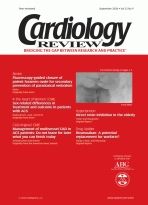Publication
Article
Cardiology Review® Online
Continuing Medical Education Exam
Target: Women’s Health
“Sex-related differences in treatment and outcome in patients with ACS”
Learning objectives
Describe the differences in baseline characteristics, treatment, and in-hospital outcomes between men and women with acute coronary syndrome (ACS) included in the AMIS (Acute Myocardial Infarction in
Switzerland
) Plus prospective cohort study.
All of the following baseline characteristics were observed more frequently in women than in men enrolled in the AMIS Plus prospective cohort study, EXCEPT:
1.
Older age
a.
Preexisting hypertension
b.
Preexisting diabetes
c.
Overweight
d.
On average, women arrived at the hospital an additional________ after symptom onset compared with men.
2.
30 minutes
a.
1 hour
b.
1½ hours
c.
2 hours
d.
Once admitted to the hospital, women were less likely to undergo percutaneous coronary intervention or thrombolysis than men and were generally treated with different drug regimens. The only pharmacologic treatment administered to women as frequently as to men was:
Clopidogrel
3. a.
Glycoprotein IIb/IIIa antagonist
b.
Nitrate
c.
Simvastatin
d.
After adjusting for covariables, it was determined that sex was not an independent predictor of in-hospital mortality for ACS patients; however, despite this adjustment, the rate of in-hospital mortality was greater in which group of women compared with men?
4.
Women aged 51 to 60 years
a.
Women
≥61 years
b.
Women ranked Killip class I or II on admission
c.
Women presenting with atrial fibrillation
d.
Which trial found that employing an early invasive approach in ACS patients with non—ST-segment elevation benefitted both men and women?
5.
AMIS Plus
a.
TACTICS—TIMI
FRISC II
RITA 3
d.
b.c.
CAD/Angina
“Management of multivessel CAD in ACS patients: Do not leave for later what you can finish today”
Target:
Learning objectives
Understand the efficacy of single-vessel percutaneous
coronary intervention (PCI) versus multivessel PCI in acute coronary syndrome (ACS) patients who are found to have multivessel coronary artery disease.
Of the patients from the
1.
American
College
of Cardiology National Cardiovascular Database Registry included for analysis, those most likely to receive multivessel versus single-vessel PCI had:
Non—ST-segment elevation (NSTE) myocardial
a.
infarction (MI)
A lower ejection fraction
b.
≥
1 chronically occluded arteries
c.
Proximal left anterior descending arterial stenosis
d.
Important independent predictors of single-vessel PCI included all of the following, EXCEPT:
2.
Presence of unstable angina without troponin
a.
elevation
Presence of renal dysfunction
b.
Older age
c.
History of PCI
d.
TIMI-3 flow and less than 20% stenosis at the end of PCI was achieved in ____ of single-vessel PCIs and in ____ pf multivessel PCIs.
3.
95%; 90%
a.
91%; 88%
b.
91%; 85%
c.
88%; 91%
d.
Which periprocedural complication was experienced most frequently in the multivessel PCI group?
4.
Myocardial infarction
a.
Heart failure
b.
Emergency repeat PCI
c.
Unplanned coronary artery bypass graft surgery
d.
Based on their review and others’ observations, the authors conclude that multivessel PCI in the setting of NSTE-ACS is safe and can offer advantages compared with single-vessel PCI, including:
5.
A lower composite of death, MI, or revascularization
a.
Lower incidence of heart failure
b.
Fewer repeat interventions
c.
All of the above
d.






